Numerical Modelling and Multi Objective Optimization Analysis of Heavy Vehicle Chassis
Abstract
:1. Introduction
2. Methodology
2.1. The Simulation Environment
2.2. Chassis Specifications
2.3. CAD Modelling
3. Results and Discussion
3.1. FE Results on a Standard Chassis
3.2. Optimization of Standard Chassis
3.2.1. Total Deformation
- 58.5 mm (−10%) for cross member 1, 65 mm for member 2 and 65 mm for member 3.
- 65 mm for cross member 1, 65 mm for member 2 and 71.5 mm (+10%) for member 3.
- 60.67 mm (−6.6%) for cross member 1, 65 mm for member 2 and 61.53 (−5.3%) mm for member 3.
- 65 mm for cross member 1, 67.6 mm (+4%) for member 2 and 71.07 (+9.3%) mm for member 3.
3.2.2. Equivalent Stress
- 65 mm for cross member 1, 71.5 mm (+10%) for member 2 and 65 mm for member 3.
- 65 mm for cross member 1, 65 mm for member 2 and 71.5 mm (+10%) for member 3.
- 58.933 mm (−9.3%) for cross member 1, 60.667 mm (−6.7%) for member 2 and 65.867 mm (+1.5%) for member 3.
- 62.4 mm (−1.4%) for cross member 1, 61.533 mm (−5.3%) for member 2 and 70.2 mm (+8%) for member 3.
3.2.3. Solid Mass
- 70.2 mm (+8%) for cross member 1, 65.867 mm (1.34%) for member 2, 69.333 mm (+6.7%) for member 3.
3.2.4. Surface Response
Equivalent Stresses Surface Response
Mass Surface Response
3.2.5. Sensitivity
4. Conclusions
5. Future Work
Author Contributions
Funding
Conflicts of Interest
Appendix A
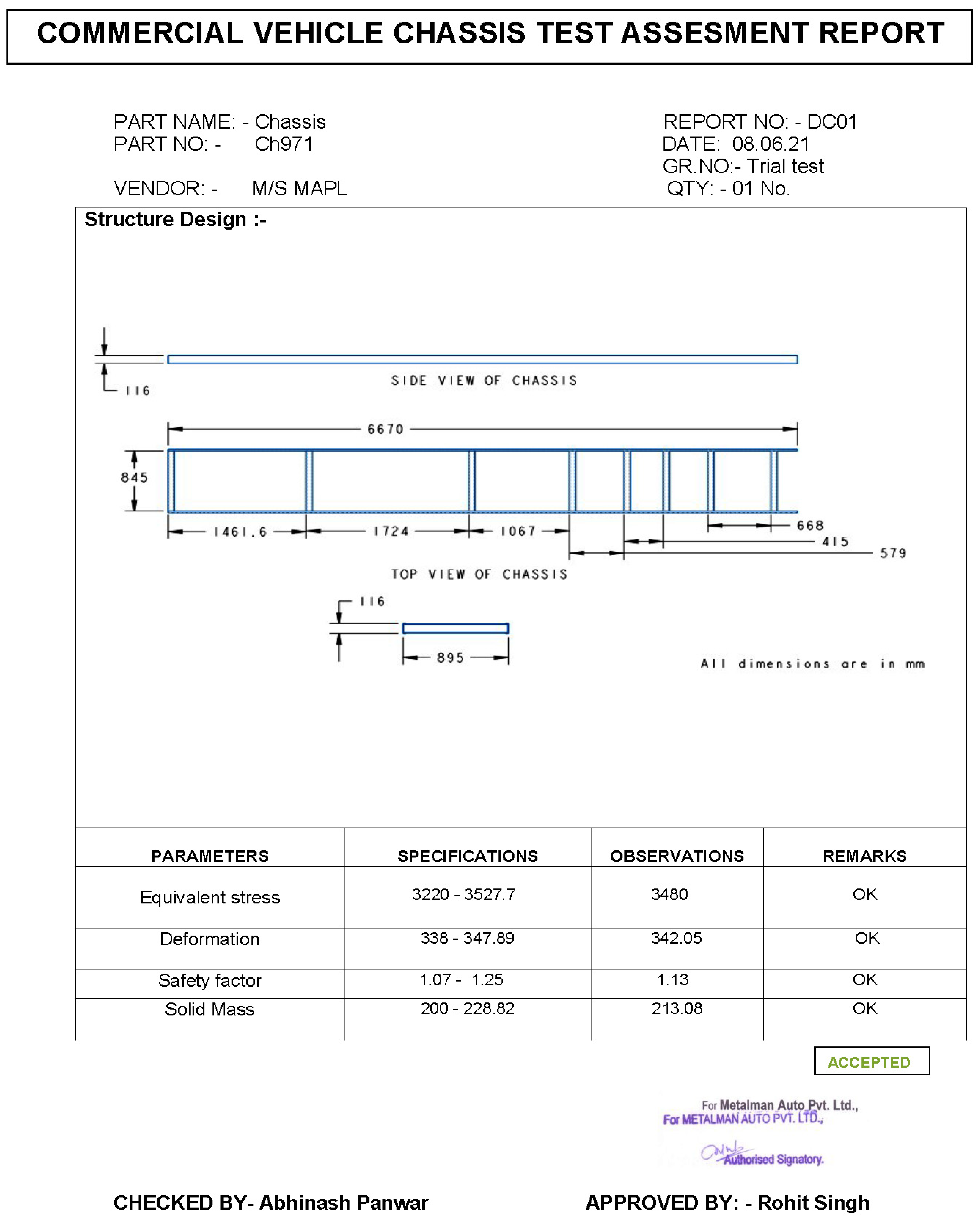
References
- Karaoǧlu, C.; Kuralay, N.S. Stress analysis of a truck chassis with riveted joints. Finite Elem. Anal. Des. 2002, 38, 1115–1130. [Google Scholar] [CrossRef]
- Bhaskar, E.; Muneiah, T.; Ch, V.R. Static and Dynamic Analysis of Chassic. Int. J. Res. 2014, 1, 320–328. [Google Scholar]
- Raju, V.V.; Prasad, B.D.; Balaramakrishna, M.; Srinivas, Y. Modeling and Structural Analysis of Ladder Type Heavy Vehicle. Int. J. Multidiscip. Educ. Res. 2014, 4, 26–42. [Google Scholar]
- Kumar, N.R.H. A Text Book on Automobile Chassis and Body Engineering; Government Junior College: Palamaner, India, 2014. [Google Scholar]
- Sinha, N.; Kumar, K. Optimization of Volumetric Composition and Cross-Section of Carbon Reinforced Epoxy based Polymeric Composite Tubes in Spaceframe Chassis. Mater. Today Proc. 2019, 18, 3812–3820. [Google Scholar] [CrossRef]
- Singh, A.; Soni, V.; Singh, A. Structural Analysis of Ladder Chassis for Higher Strength. Int. J. Emerg. Technol. Adv. Eng. 2014, 4, 253–259. [Google Scholar]
- Borns, R.; Whitacre, D. Optimizing Designs of Aluminum Suspension Components Using an Integrated Approach; SAE Technical Paper Series; SAE International: Warrendale, PA, USA, 2005. [Google Scholar] [CrossRef]
- Cavazzuti, M.; Costi, D.; Baldini, A.; Moruzzi, P. Automotive chassis topology optimization: A comparison between spider and coupé designs. Proc. World Congr. Eng. 2011, 3, 2289–2293. [Google Scholar]
- Cavazzuti, M.; Splendi, L. Structural Optimization Of Automotive Chassis: Theory, Set Up, Design. In Proceedings of the Problèmes Inverses, Contrôle et Optimisation de Formes, Parigi, Indonesia, 2–4 April 2012. [Google Scholar]
- Chiandussi, G.; Gaviglio, I.; Ibba, A. Topology optimisation of an automotive component without final volume constraint specification. Adv. Eng. Softw. 2004, 35, 609–617. [Google Scholar] [CrossRef]
- Pedersen, C.B. Crashworthiness design of transient frame structures using topology optimization. Comput. Methods Appl. Mech. Eng. 2004, 193, 653–678. [Google Scholar] [CrossRef]
- Duddeck, F. Multidisciplinary optimization of car bodies. Struct. Multidiscip. Optim. 2008, 35, 375–389. [Google Scholar] [CrossRef]
- Bhat, K.A.; Katore, H.V. The Failure Analysis of Tractor Trolley Chassis An Approach using Finite Element Method—A Review. IOSR J. Mech. Civ. Eng. 2014, 10, 24–25. [Google Scholar]
- Stalin, B. Structural Analysis of Front-End Cross Bar of a TATA407 Chassis Frame. Bonfring Int. J. Ind. Eng. Manag. Sci. 2016, 6, 120–122. [Google Scholar] [CrossRef] [Green Version]
- Yang, R.J.; Chahande, A.I. Automotive applications of topology optimization. Struct. Multidiscip. Optim. 1995, 9, 245–249. [Google Scholar] [CrossRef]
- Kang, N.; Kokkolaras, M.; Papalambros, P.Y.; Yoo, S.; Na, W.; Park, J.; Featherman, D. Optimal design of commercial vehicle systems using analytical target cascading. Struct. Multidiscip. Optim. 2014, 50, 1103–1114. [Google Scholar] [CrossRef]
- Deore, E.R.; Patil, H.B.; Kachave, S.D. Stress Analysis of Automotive Chassis with Various Thicknesses. IOSR J. Mech. Civ. Eng. 2011, 6, 44–49. [Google Scholar]
- Patel, V.; Patel, V.V.; Patel, R.I. Structural Analysis of Automotive Chassis Frame and Design Modification for Weight Reduction. World J. Sci. Technol. 2012, 2012, 1–6. [Google Scholar] [CrossRef]
- Sharma, P.K.; Parekh, N.J.; Nayak, D. Optimization and Stress Analysis of Chassis in TATA Turbo Truck SE1613. Int. J. Eng. Adv. Technol. 2014, 3, 182–187. [Google Scholar]
- Rajasekar, K.; Saravanan, R.; Dhandapani, N. Design and Optimization of Variable Rectangular Cross Section Chassis for On-Road Heavy Vehicles. Int. J. Veh. Struct. Syst. 2016, 8, 11–16. [Google Scholar] [CrossRef]
- Feng, G.; Jia, S.; Li, N.; Lin, H. Push rod failure analysis of a mining heavy dump truck. Eng. Fail. Anal. 2012, 25, 193–199. [Google Scholar] [CrossRef]
- Patil, R.V.; Marathe, J.; Tadamalle, A.; Reddy, Y. Optimization of tractor trolley chassis using orthogonal array method. Mater. Today: Proc. 2017, 4, 8796–8805. [Google Scholar] [CrossRef]
- Srivastava, J.P.; Reddy, G.G.; Teja, K.S. Numerical investigation on vibration characteristics and structural behaviour of different go-kart chassis configuration. Mater. Today Proc. 2021, 39, 176–182. [Google Scholar] [CrossRef]
- Prabakaran, S. Structural Analysis of Chassis Frame and Modification for Weight Reduction. Int. J. Eng. Sci. Res. Technol. 2014, 3, 1–6. [Google Scholar]
- De Oliveira, F.C.G.; Borges, J.A.F. Design and Optimization of a Space frame Chassis; SAE Technical Paper Series; SAE International: Warrendale, PA, USA, 2008. [Google Scholar] [CrossRef]
- Agarwal, A.; Molwane, O.B.; Marumo, R. Design Optimization of Knuckle Stub Using Response Surface Optimization. In Advances in Lightweight Materials and Structures; Kumar, A.P., Dirgantara, T., Krishna, P.V., Eds.; Springer: Singapore, 2020; pp. 155–164. [Google Scholar] [CrossRef]
- Monika, S. Finite Element Analysis of Truck Chassis Frame. Int. Res. J. Eng. Technol. 2015, 2, 1949–1956. [Google Scholar]
- ANSYS. Advantages to Using a Small-Sliding Contact in Your Structural Analysis. Ansys Blog. 2018. Available online: https://www.ansys.com/blog/small-sliding-contacts-can-improve-structural-analysis (accessed on 15 June 2020).
- Plasun, R. Central Composite Designs. Available online: https://www.iue.tuwien.ac.at/phd/plasun/node32.html (accessed on 10 January 2020).
- Overview of Space-Filling Designs. 2018. Available online: https://www.datadvance.net/product/pseven-core/generic-tool-for-design-of-experiments/ (accessed on 20 February 2020).
- Optimization Process in ANSYS Workbench Software. Available online: https://www.mr-cfd.com/services/design-of-experiments-doe/ (accessed on 20 February 2020).





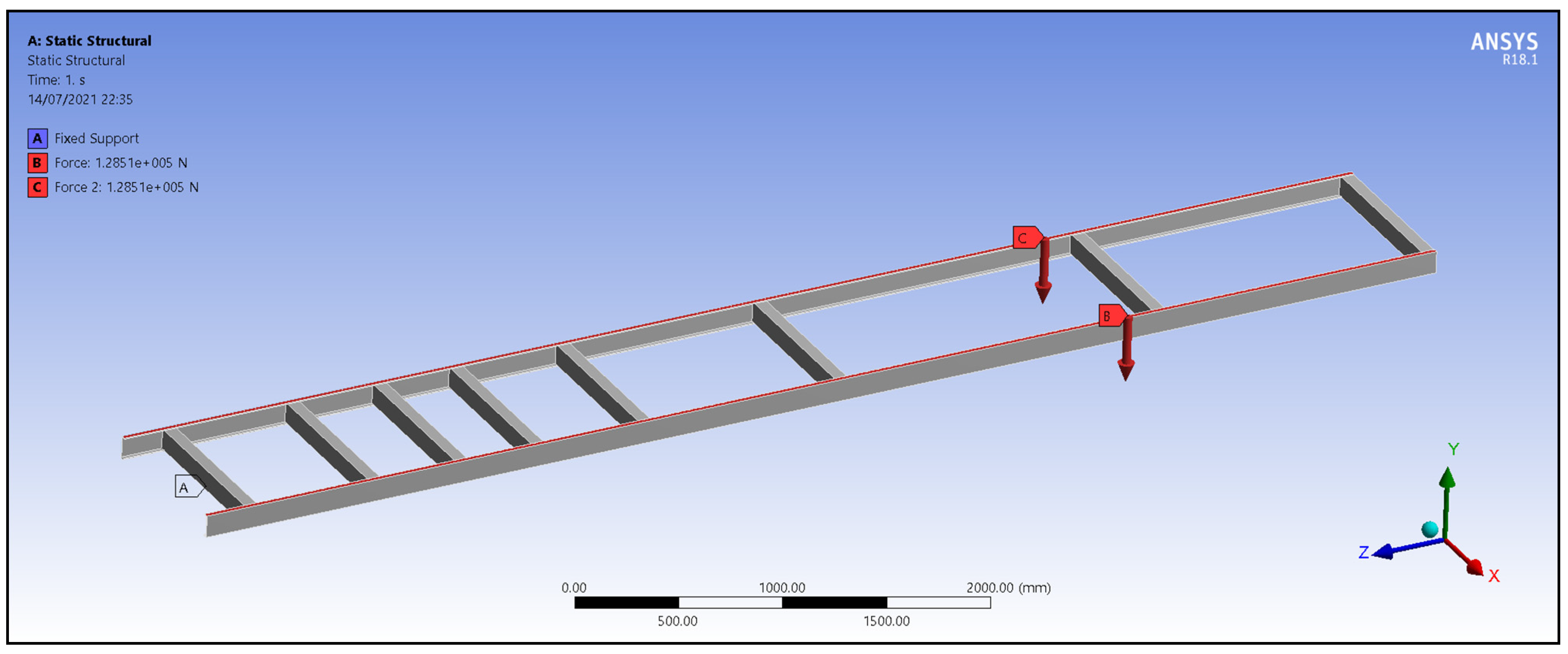
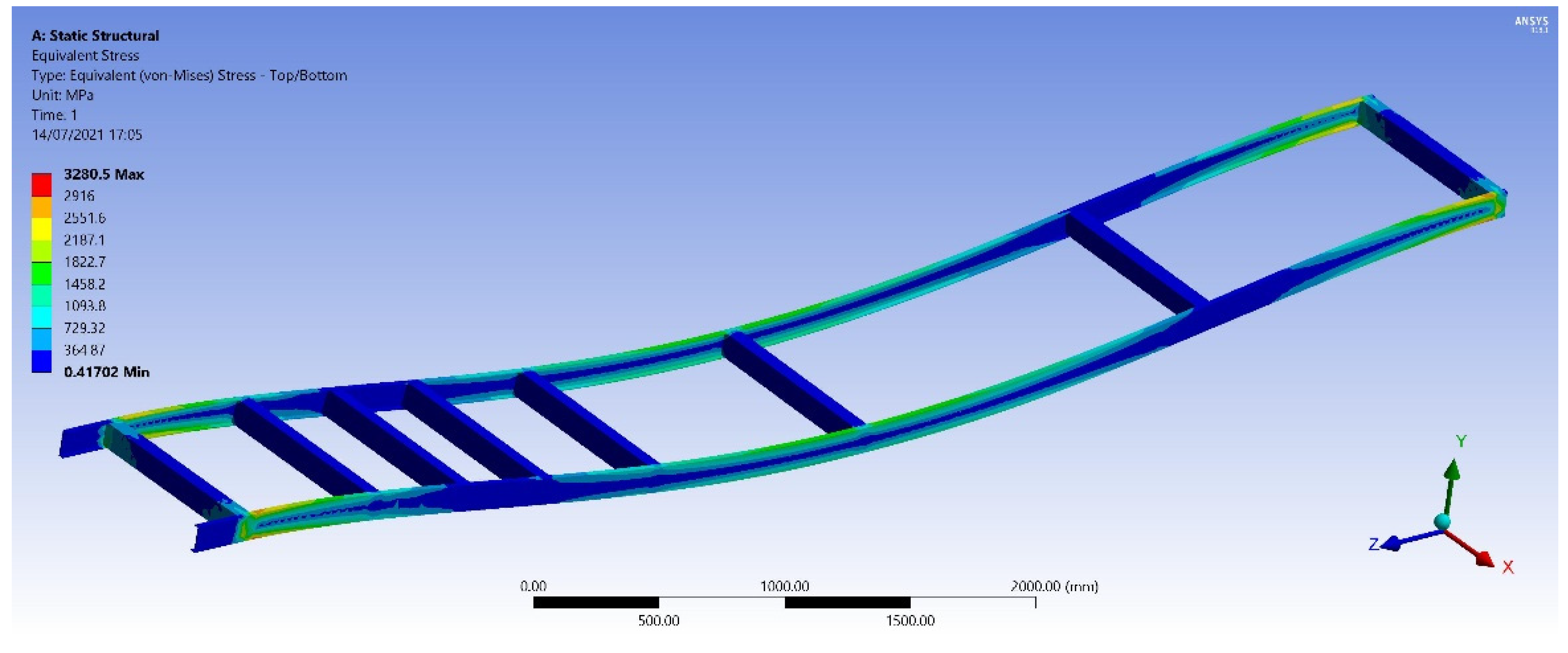
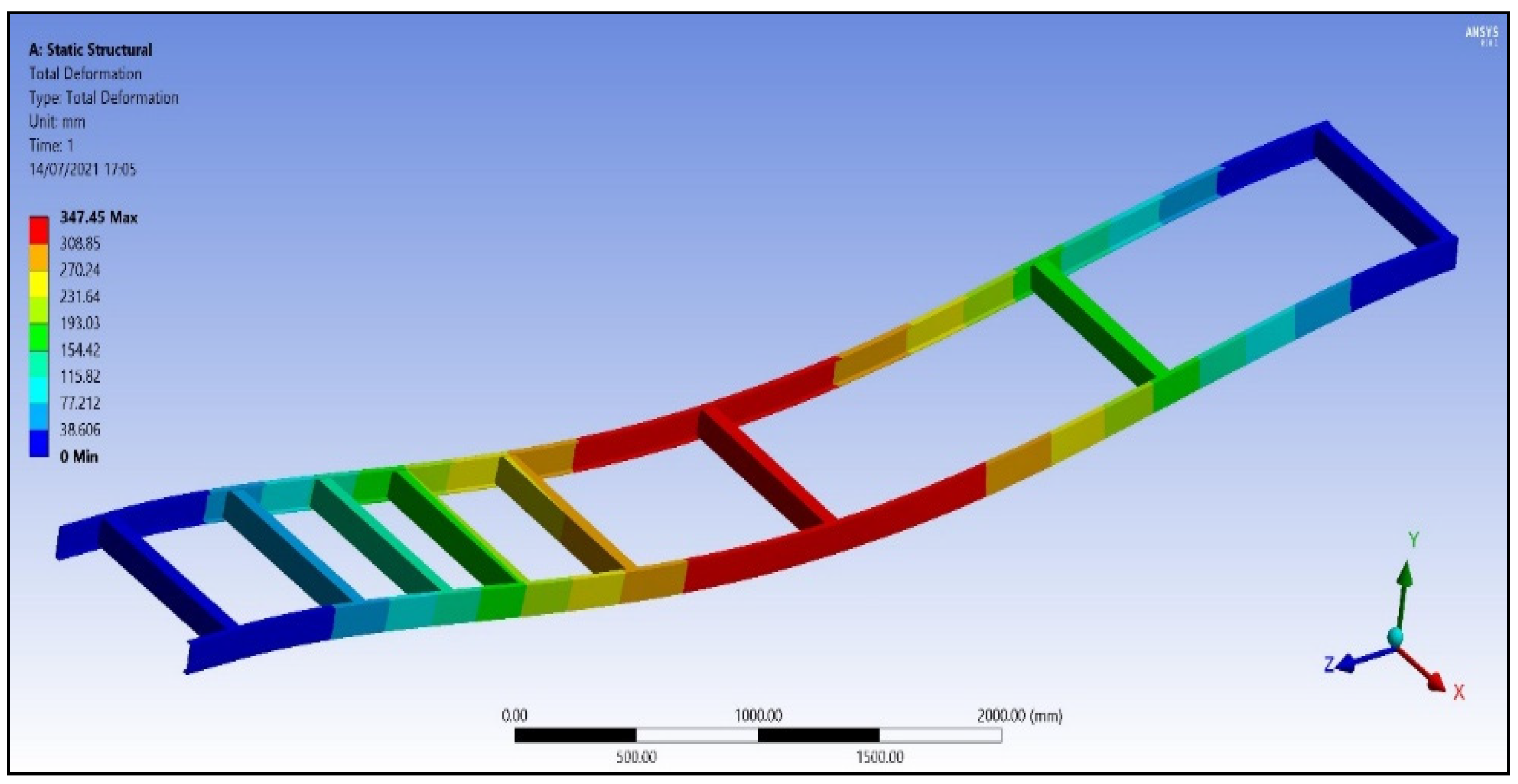
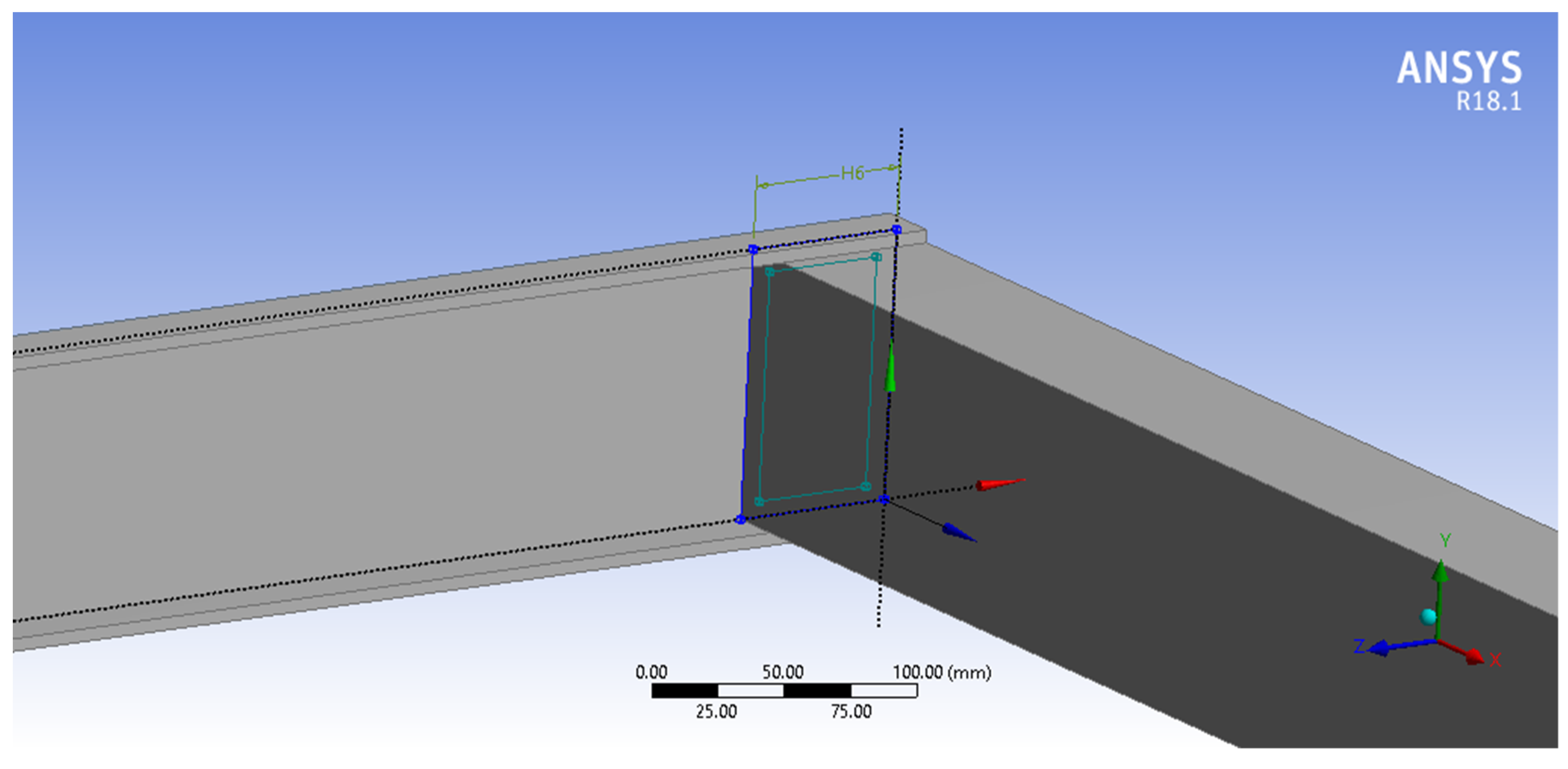
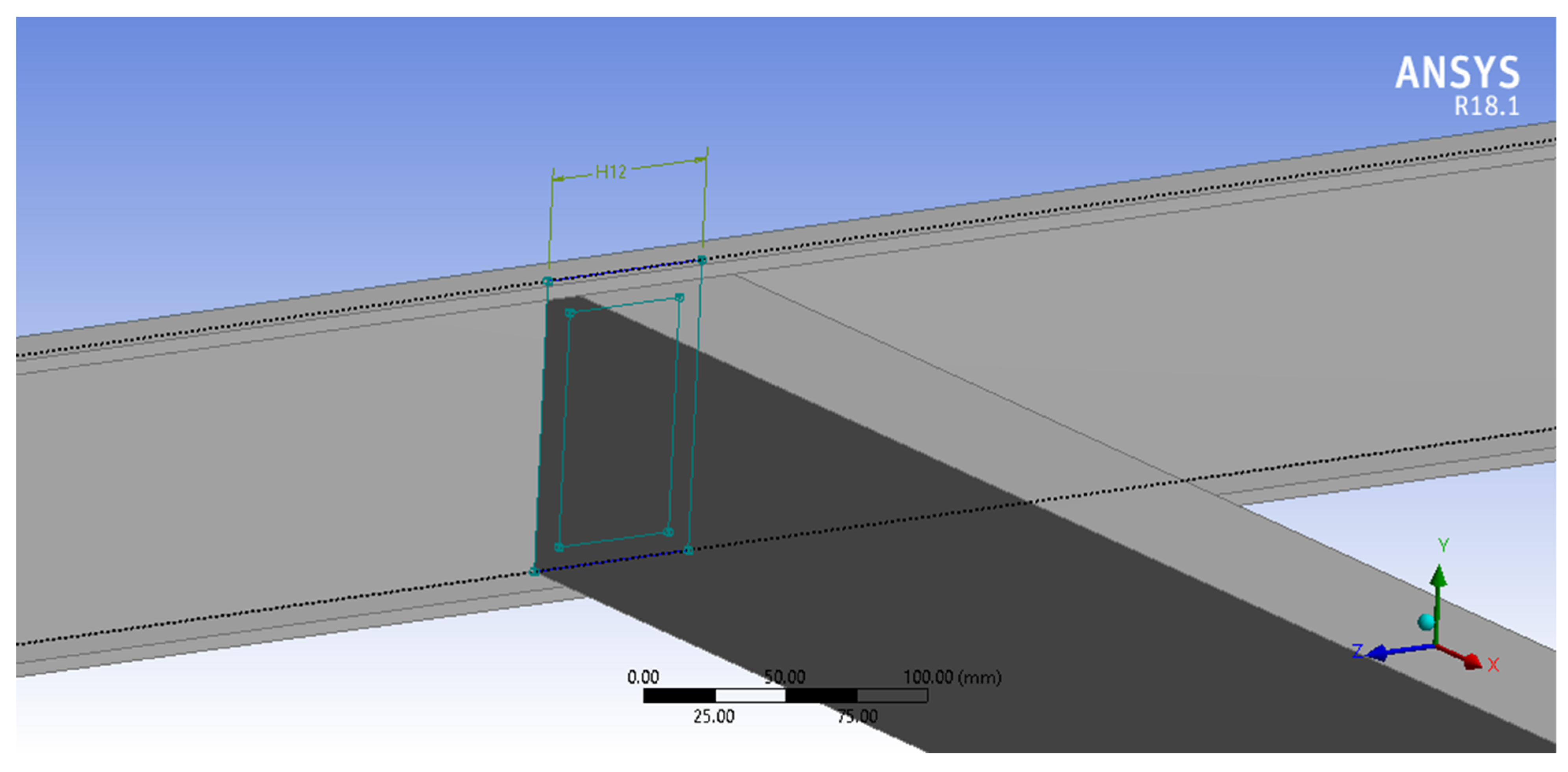


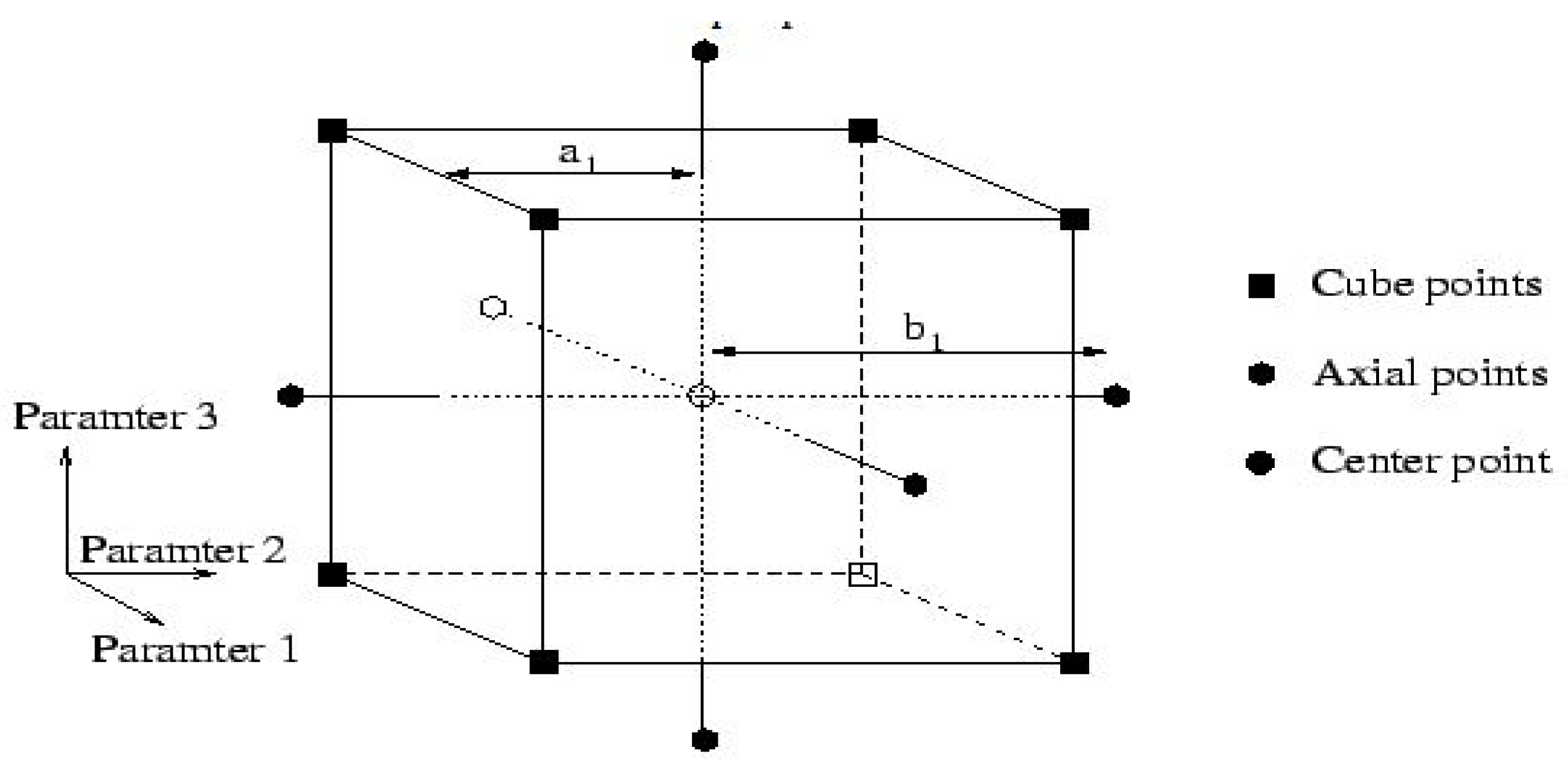
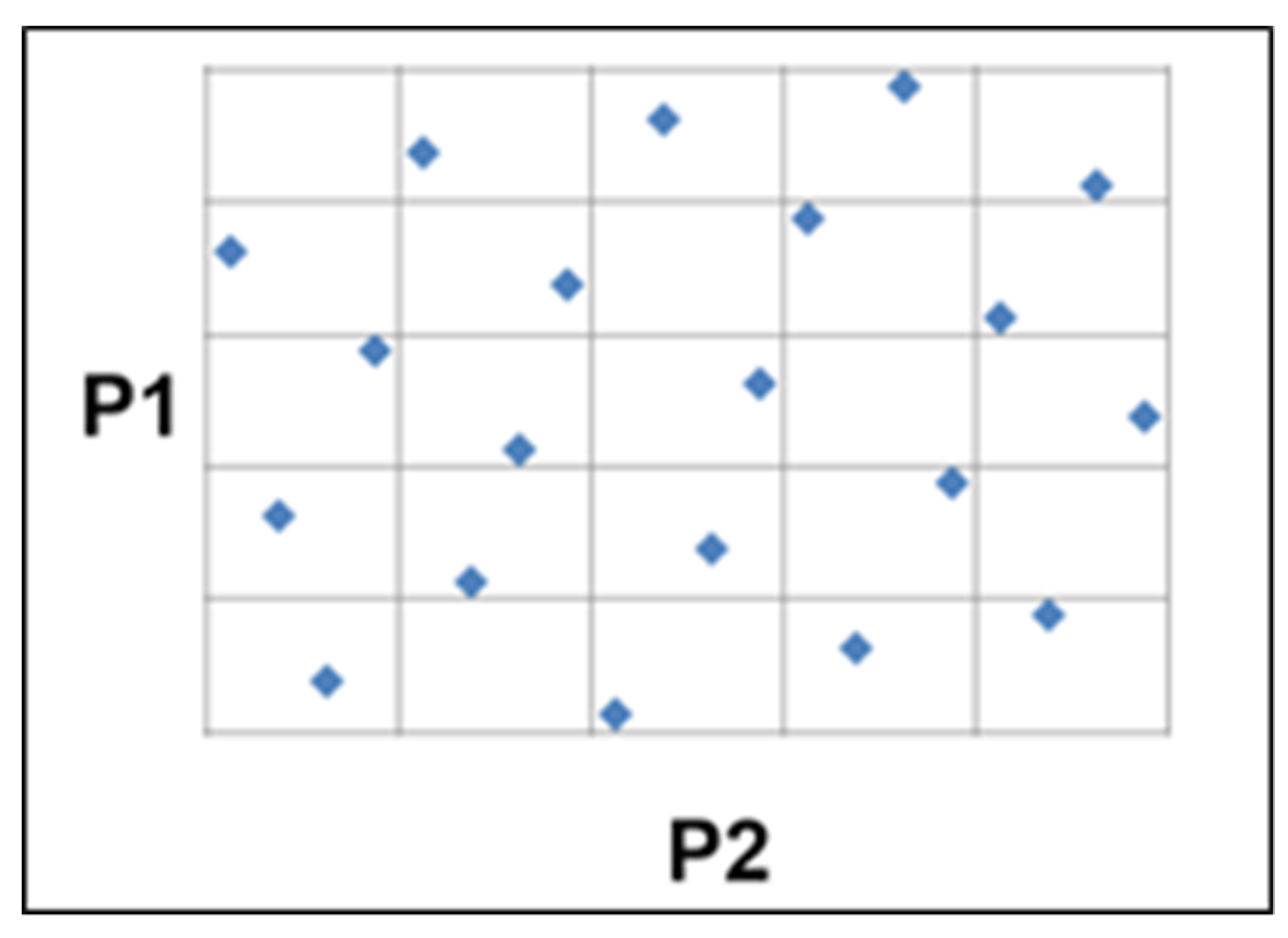
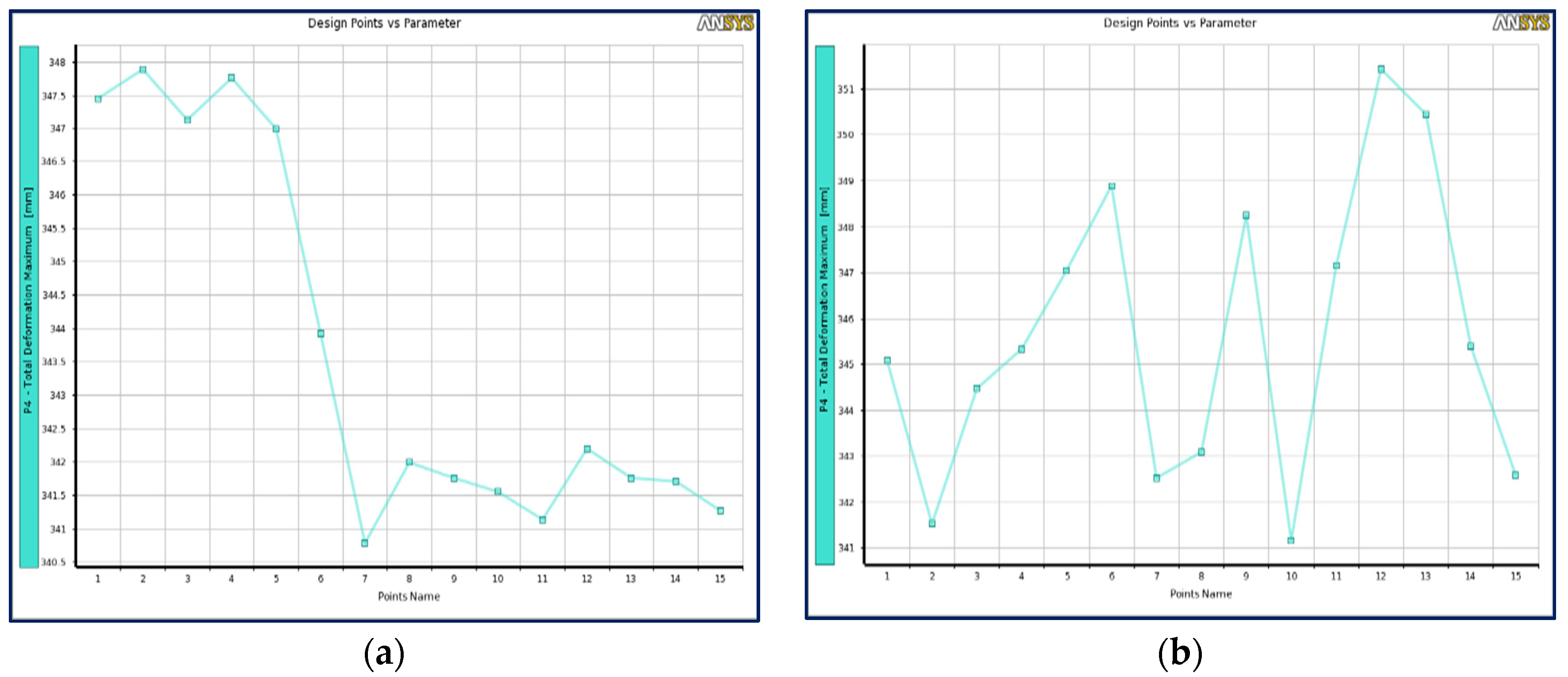
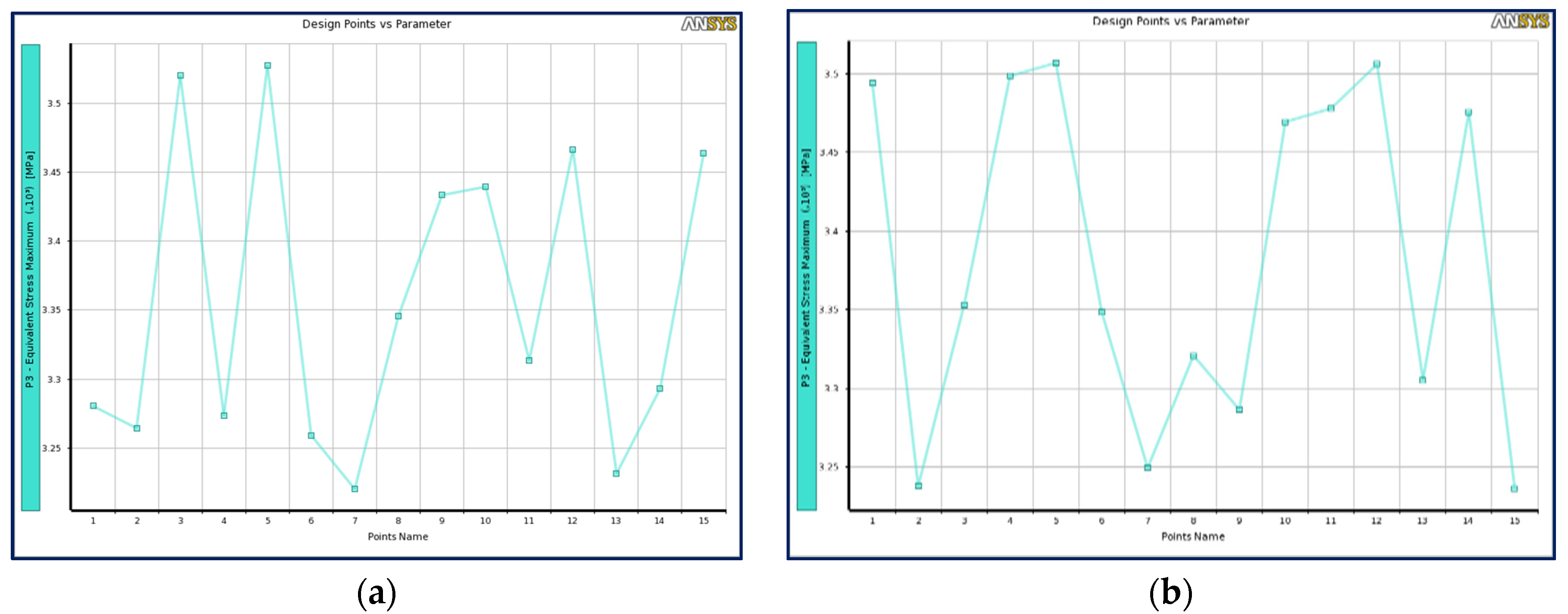
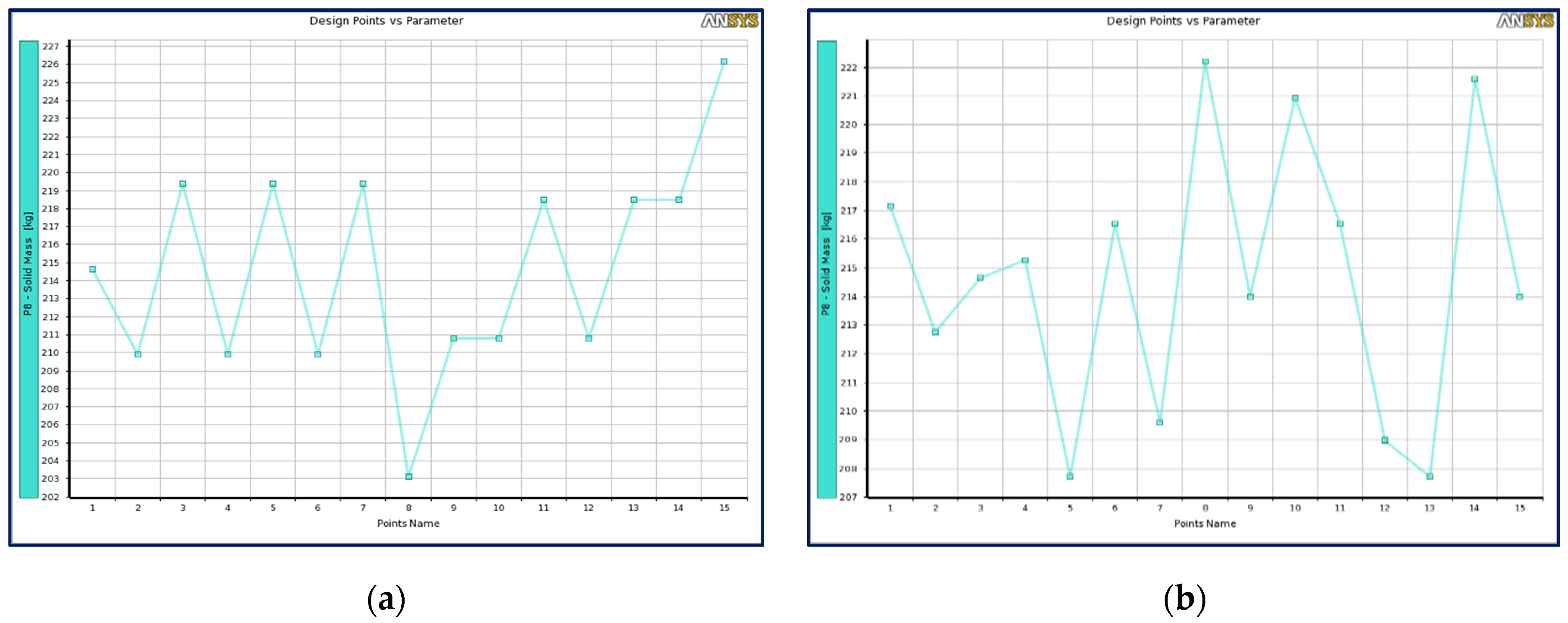
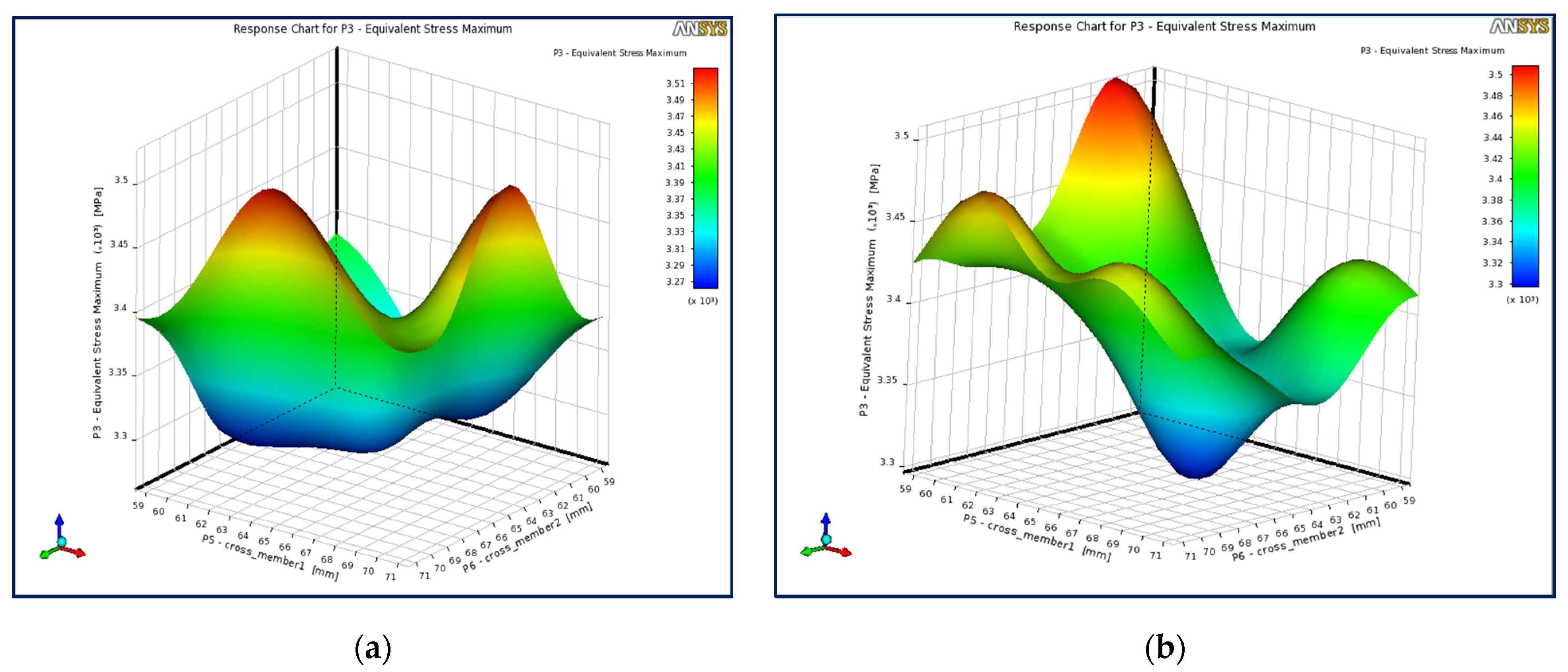
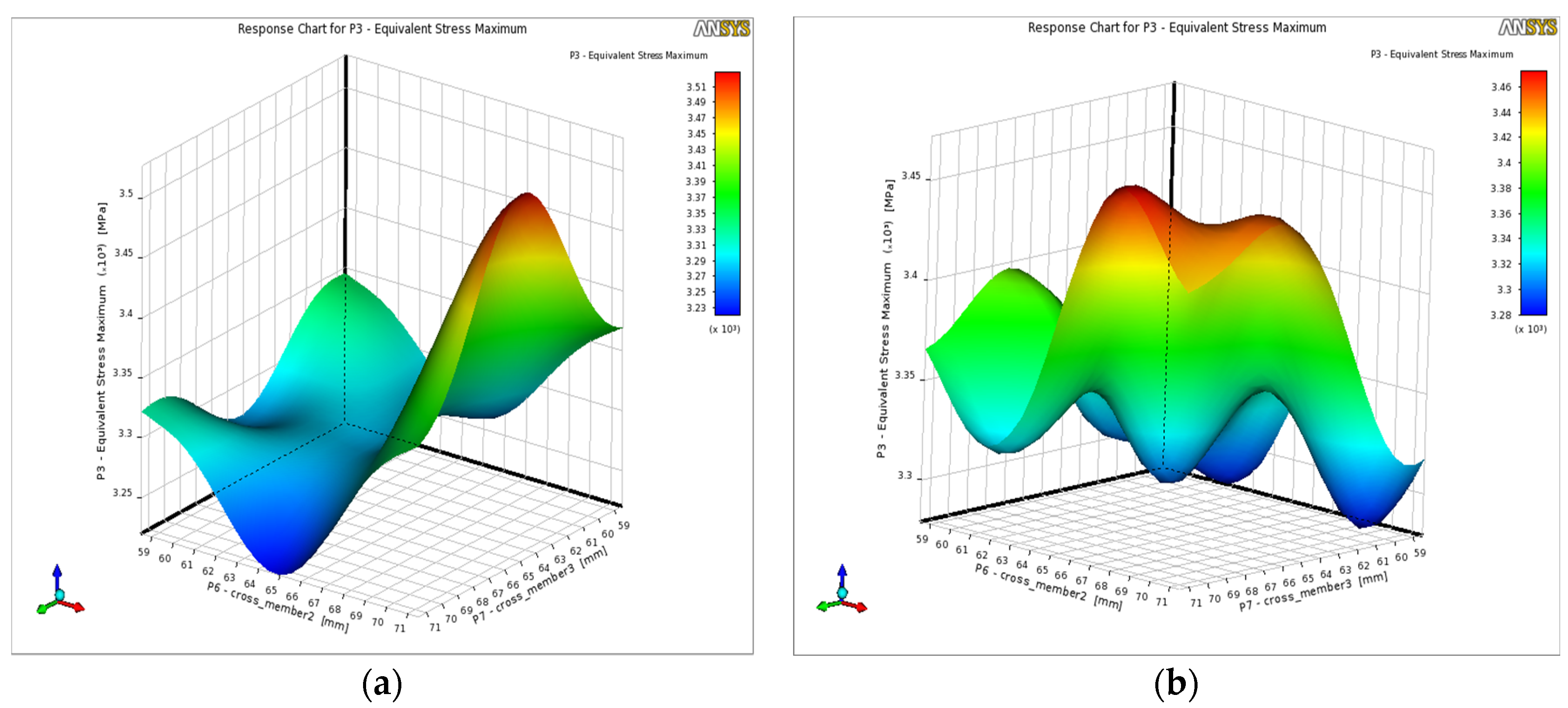

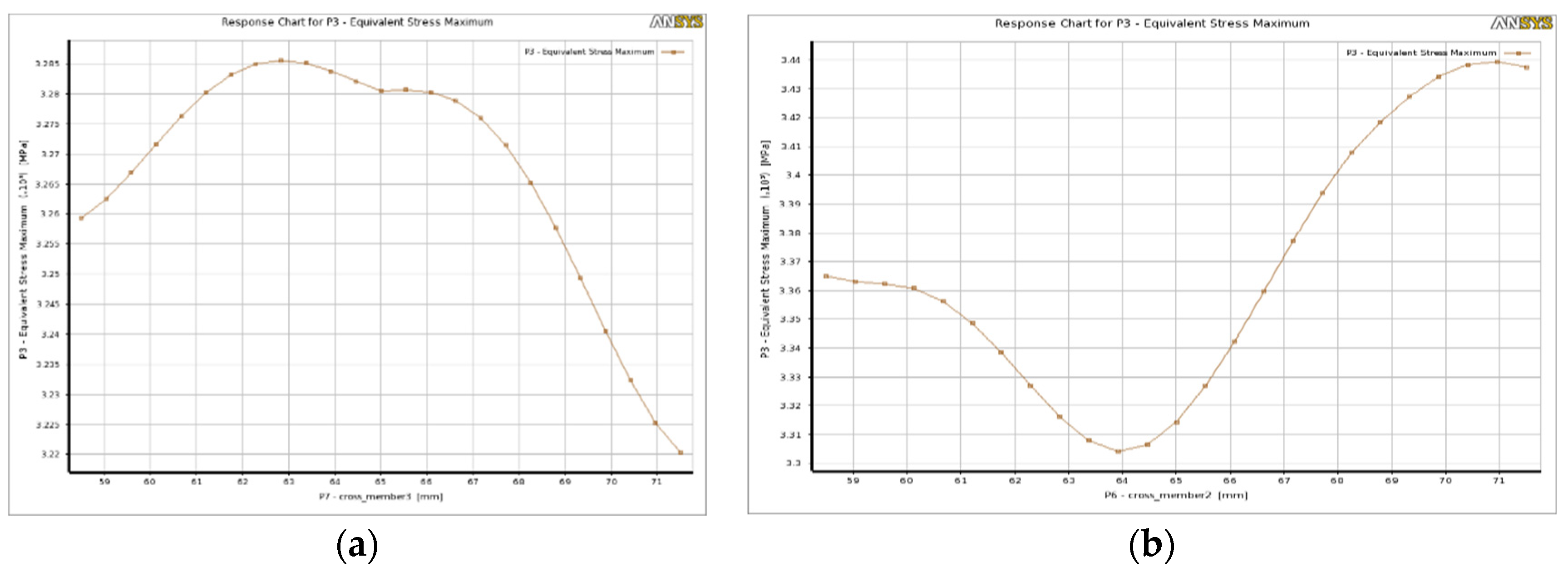



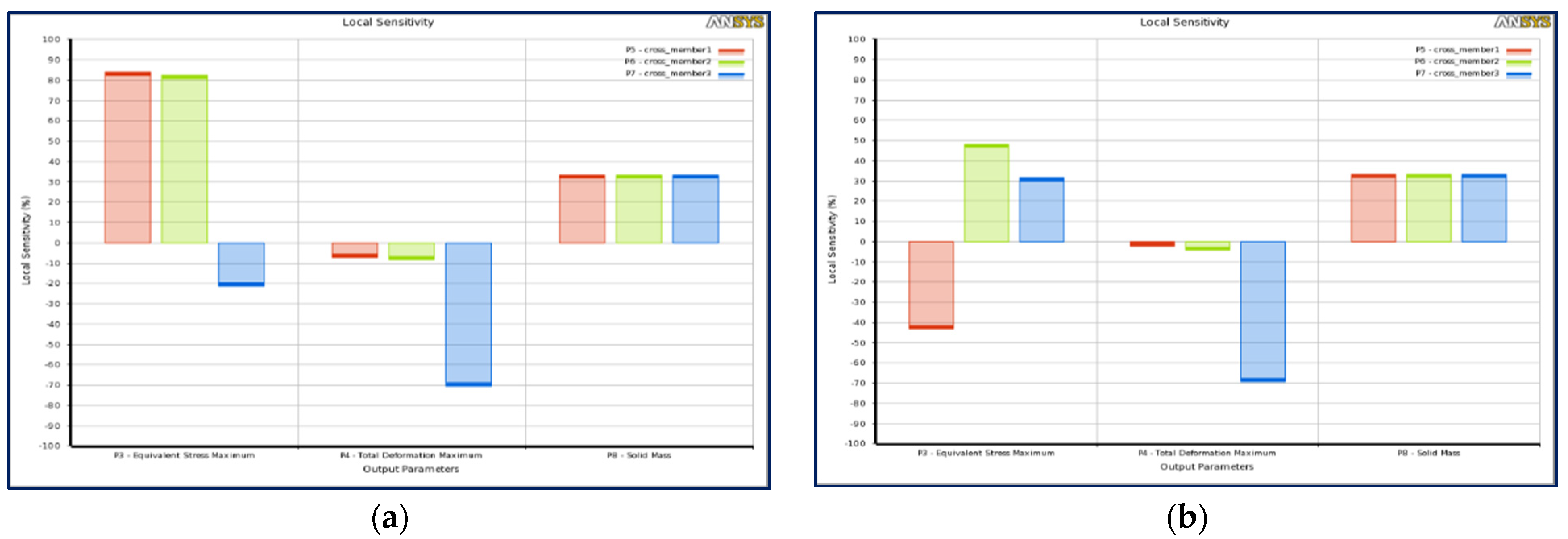
| Vehicle Name | TATA 1612 |
|---|---|
| Frame Section | C type (116 mm × 25 mm × 5 mm) |
| Front Overhang (a) | 740 mm |
| Rear Overhang (c) | 1400 mm |
| Wheel Base (b) | 6670 mm |
| Total Load acting on chassis | 257,022 N |
| Load acting on each beam | 128,511 N/Beam |
| Stress produced on the beam (σ) | 3297.422 N/mm2 |
| Material of Chassis | St 52 E |
| Variable Name | Lower Bound | Upper Bound |
|---|---|---|
| Cross Member 1 | 58.5 mm | 71.5 mm |
| Cross Member 2 | 58.5 mm | 71.5 mm |
| Cross Member 3 | 58.5 mm | 71.5 mm |
| A | B | C | D | E | F | G | |
|---|---|---|---|---|---|---|---|
| 1 | Name | P5 - cross_member1 (mm) | P6 - cross_member2 (mm) | P7 - cross_member3 (mm) | P3 - Equivalent Stress Max (MPa) | P4 - Total Deformation Max (mm) | P8 - Solid Mass (kg) |
| 2 | 1 | 65 | 65 | 65 | 3280.49 | 347.4546 | 214.6414 |
| 3 | 2 | 58.5 | 65 | 65 | 3264.454 | 347.8886 | 209.9142 |
| 4 | 3 | 71.5 | 65 | 65 | 3520.136 | 347.1296 | 219.3685 |
| 5 | 4 | 65 | 58.5 | 65 | 3273.633 | 347.7588 | 209.9142 |
| 6 | 5 | 65 | 71.5 | 65 | 3527.463 | 346.9958 | 219.3685 |
| 7 | 6 | 65 | 65 | 58.5 | 3259.301 | 343.9264 | 209.9142 |
| 8 | 7 | 65 | 65 | 71.5 | 3220.32 | 340.7808 | 219.3685 |
| 9 | 8 | 59.71528 | 59.71528 | 59.71528 | 3345.578 | 341.9918 | 203.1113 |
| 10 | 9 | 70.28472 | 59.71528 | 59.71528 | 3433.409 | 341.7593 | 210.798 |
| 11 | 10 | 59.71528 | 70.28472 | 59.71528 | 3439.451 | 341.5502 | 210.798 |
| 12 | 11 | 70.28472 | 70.28472 | 59.71528 | 3313.501 | 341.1359 | 218.4847 |
| 13 | 12 | 59.71528 | 59.71528 | 70.28472 | 3466.476 | 342.1991 | 210.798 |
| 14 | 13 | 70.28472 | 59.71528 | 70.28472 | 3231.431 | 341.758 | 218.4847 |
| 15 | 14 | 59.71528 | 70.28472 | 70.28472 | 3293.051 | 341.7089 | 218.4847 |
| 16 | 15 | 70.28472 | 70.28472 | 70.28472 | 3464.079 | 341.2692 | 226.1714 |
| A | B | C | D | E | F | G | |
|---|---|---|---|---|---|---|---|
| 1 | Name | P5 - cross_member1 (mm) | P6 - cross_member2 (mm) | P7 - cross_member3 (mm) | P3 - Equivalent Stress Max (MPa) | P4 - Total Deformation Max (mm) | P8 - Solid Mass (kg) |
| 2 | 1 | 69.33333 | 68.46667 | 60.66667 | 3494.398 | 345.0904 | 217.1625 |
| 3 | 2 | 63.26667 | 69.33333 | 59.8 | 3237.664 | 341.5257 | 212.7505 |
| 4 | 3 | 59.8 | 66.73333 | 68.46667 | 3352.964 | 344.4751 | 214.6414 |
| 5 | 4 | 68.46667 | 59.8 | 67.6 | 3498.669 | 345.3408 | 215.2717 |
| 6 | 5 | 58.93333 | 60.66667 | 65.86667 | 3507.02 | 347.0544 | 207.7082 |
| 7 | 6 | 71.06667 | 63.26667 | 63.26667 | 3348.538 | 348.8975 | 216.5322 |
| 8 | 7 | 66.73333 | 62.4 | 58.93333 | 3249.308 | 342.5268 | 209.5991 |
| 9 | 8 | 70.2 | 65.86667 | 69.33333 | 3320.901 | 343.0932 | 222.2048 |
| 10 | 9 | 65.86667 | 64.13333 | 64.13333 | 3286.35 | 348.261 | 214.0111 |
| 11 | 10 | 65 | 67.6 | 71.06667 | 3469.519 | 341.1595 | 220.9442 |
| 12 | 11 | 61.53333 | 71.06667 | 65 | 3478.07 | 347.1521 | 216.5322 |
| 13 | 12 | 60.66667 | 65 | 61.53333 | 3506.208 | 351.4384 | 208.9688 |
| 14 | 13 | 64.13333 | 58.93333 | 62.4 | 3305.275 | 350.4504 | 207.7082 |
| 15 | 14 | 67.6 | 70.2 | 66.73333 | 3475.766 | 345.3902 | 221.5745 |
| 16 | 15 | 62.4 | 61.53333 | 70.2 | 3236.134 | 342.5801 | 214.0111 |
Publisher’s Note: MDPI stays neutral with regard to jurisdictional claims in published maps and institutional affiliations. |
© 2021 by the authors. Licensee MDPI, Basel, Switzerland. This article is an open access article distributed under the terms and conditions of the Creative Commons Attribution (CC BY) license (https://creativecommons.org/licenses/by/4.0/).
Share and Cite
Agarwal, A.; Mthembu, L. Numerical Modelling and Multi Objective Optimization Analysis of Heavy Vehicle Chassis. Processes 2021, 9, 2028. https://doi.org/10.3390/pr9112028
Agarwal A, Mthembu L. Numerical Modelling and Multi Objective Optimization Analysis of Heavy Vehicle Chassis. Processes. 2021; 9(11):2028. https://doi.org/10.3390/pr9112028
Chicago/Turabian StyleAgarwal, Abhishek, and Linda Mthembu. 2021. "Numerical Modelling and Multi Objective Optimization Analysis of Heavy Vehicle Chassis" Processes 9, no. 11: 2028. https://doi.org/10.3390/pr9112028







